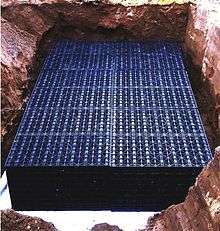Dry well
A dry well or drywell is an underground structure that disposes of unwanted water, most commonly surface runoff and stormwater and in some cases greywater. It is a covered, porous-walled chamber that allows water to slowly soak into the ground (that is, percolate), dissipating into the groundwater. Such structures are often called a soakaway in the United Kingdom, a soakwell in Australia,[1] and a soak pit in India.

A sump in a basement can be built in dry well form, allowing the sump pump to cycle less frequently (handling only occasional peak demand). A French drain can resemble a horizontal dry well that is not covered. A larger open pit or artificial swale that receives stormwater and dissipates it into the ground is called an infiltration basin or recharge basin. In places where the amount of water to be dispersed is not as large, a rain garden can be used instead.
A dry well is a passive structure. Water flows through it under the influence of gravity. A dry well receives water from one or more entry pipes or channels at its top and discharges the same water through a number of small exit openings distributed over a larger surface area in the side(s) and bottom of the dry well. When a dry well is above the water table, most of its internal volume will contain air. Such a dry well can accept an initial inrush of water very quickly, until the air is displaced. After that, the dry well can only accept water as fast as it can dissipate water. Some dry wells deliberately incorporate a large storage capacity so that they can accept a large amount of water very quickly and then dissipate it gradually over time, a method that is compatible with the intermittent nature of rainfall. A dry well maintains the connection between its inflow and outflow openings by resisting collapse and resisting clogging.
Simple dry wells consist of a pit filled with gravel, riprap, rubble, or other debris. Such pits resist collapse but do not have much storage capacity because their interior volume is mostly filled by stone. A more advanced dry well defines a large interior storage volume by a concrete or plastic chamber with perforated sides and bottom. These dry wells are usually buried completely so that they do not take up any land area. The dry wells for a parking lot's storm drains are usually buried below the same parking lot.
A covered pit that disposes of the water component of sewage by the same principle as a dry well is called a cesspool. A septic drain field operates on the same slow-drain/large-area principle as an infiltration basin.

See also
References
- Davis, Jacques. "Environmentalist". Perth Soakwells Pty Ltd. Retrieved 13 March 2016.
- DRYWELLS, Environmental Services, City of Portland, OR
- New Jersey Stormwater - Best Management Practices Manual, Chapter 9.3 Standard for Dry Wells, February 2004
- Philadelphia Watershed, Dry Well, Philadelphia Water Department
- Water Quality Division: Permits: Drywell Program, Arizona Department of Environmental Water Quality